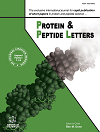- Home
- A-Z Publications
- Protein and Peptide Letters
- Previous Issues
- Volume 25, Issue 1, 2018
Protein and Peptide Letters - Volume 25, Issue 1, 2018
Volume 25, Issue 1, 2018
-
-
Utilization of Proteins and Peptides to Create Organic-Hydroxyapatite Hybrids
More LessAuthors: Kazutoshi Iijima and Mineo HashizumeBackground: Various types of proteins play important roles in the biomineralization of hydroxyapatite (HAp, Ca10(PO4)6(OH)2). The resulting organic-HAp nanohybrids have highlyorganized hierarchical structures that show unique morphological, structural, and mechanical properties. By mimicking the biomineralization process, organic-HAp hybrid materials have been created by utilizing proteins and peptides. Objectives: Read More
-
-
-
Modification of the N-Terminus of a Calcium Carbonate Precipitating Peptide Affects Calcium Carbonate Mineralization
More LessAuthors: Kenji Usui, Shin-ichiro Yokota, Makoto Ozaki, Shungo Sakashita, Takahito Imai and Kin-ya TomizakiBackground: A core sequence (the 9 C-terminal residues) of calcification-associated peptide (CAP- 1) isolated from the exoskeleton of the red swamp crayfish was previously shown to control calcium carbonate precipitation with chitin. In addition, a modified core sequence in which the phosphorylated serine at the N terminus is replaced with serine exhibits was also previously shown to alter precipitation characteristics Read More
-
-
-
Incorporation of an N-methyl Amino Acid into a Template Peptide Alters Anisotropy in the Crystal Growth of Gold Nanoparticles Synthesized by the Peptide Template Method
More LessAuthors: Kin-ya Tomizaki, Ryuuichi Nanbu, Makoto Kasuga and Takahito ImaiBackground: Gold nanocrystals have unique physicochemical and biocompatible properties, and hold promise for use as catalysts and in the fields of electronics, photonic and/or plasmonic devices, sensing and/or imaging systems, targeted drug delivery, and photothermal therapies. A variety of organic templates have been used to control the size, shape, and structure of gold nanocrystals, and to modify their surfaces. For the Read More
-
-
-
Smartphone Assisted Naked Eye Detection of Mercury (II) Ion using Horseradish Peroxidase Inhibitive Assays
More LessAuthors: Nur K. Jamadon, Nurfatini Busairi and Amir SyahirBackground: Mercury (II) ion, Hg2+ is among the most common pollutants with the ability to affect the environment. The implications of their elevation in the environment are mainly due to the industrialization and urbanization process. Current methods of Hg2+ detection primarily depend on sophisticated and expensive instruments. Hence, an alternative and practical way of detecting Hg2+ ions is needed to go beyond the Read More
-
Volumes & issues
-
Volume 32 (2025)
-
Volume 31 (2024)
-
Volume 30 (2023)
-
Volume 29 (2022)
-
Volume 28 (2021)
-
Volume 27 (2020)
-
Volume 26 (2019)
-
Volume 25 (2018)
-
Volume 24 (2017)
-
Volume 23 (2016)
-
Volume 22 (2015)
-
Volume 21 (2014)
-
Volume 20 (2013)
-
Volume 19 (2012)
-
Volume 18 (2011)
-
Volume 17 (2010)
-
Volume 16 (2009)
-
Volume 15 (2008)
-
Volume 14 (2007)
-
Volume 13 (2006)
-
Volume 12 (2005)
-
Volume 11 (2004)
-
Volume 10 (2003)
-
Volume 9 (2002)
-
Volume 8 (2001)
Most Read This Month
Article
content/journals/ppl
Journal
10
5
false
en


